
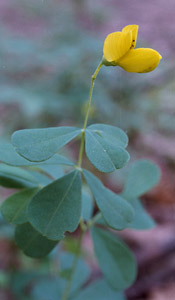

Wild Indigo, Pea family (Leguminosae), Native
 |
 |
 |

Like beans, peas, and clovers, wild indigo is a legume. This group of plants is known for capturing
nitrogen--an important plant nutrient and a key ingredient in fertilizer--from the air and incorporating
it into a chemical form that plants can use. Legumes do this in partnership with certain kinds of
bacteria (Rhizobium), which they house and nourish in root nodules. Together, the plant and
the bacteria make a chemical that protects these bacteria from oxygen, which harms them. The bacteria,
in turn, make nitrogen available to the plant. This process also enriches the soil with nitrogen.
Fringed Loosestrife, Primrose family (Primulaceae), Native

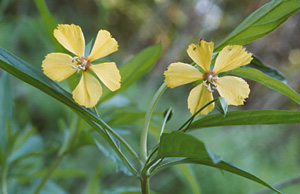
|
Fringed loosestrife is the sturdiest of three yellow loosestrifes that bloom at the Reservoir in July. They are not members of the loosestrife family (Lythraceae), which includes purple loosestrife (Lythrum salicaria). Instead, they are all members of the primrose family (Primulaceae).
The name loosestrife comes from an old belief that certain plants could calm agitated animals
(loosen their strife), such as the oxen used for farm work.

Cardinal Flower, Bluebell family (Campanulaceae), Lobelia subfamily (Lobelioideae), Native
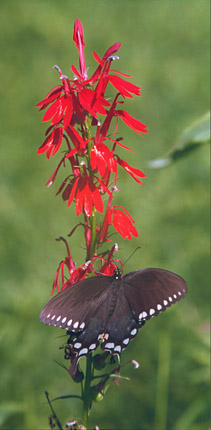
|

Cardinal flower may have been named either for the red of our native bird, the cardinal, or for the
robes of the cardinals of the Roman Catholic church. The scarlet flowers attract hummingbirds as well
as butterflies and a variety of other insects. This native North American wildflower spreads both by
seed and by shoots, which take two years to grow into mature flowering plants.
Marsh St. Johnswort, St. Johnswort family (Guttiferae or Hypericacaea), Native
 |
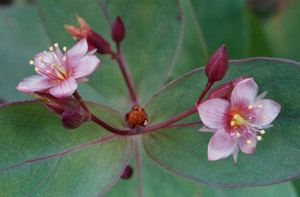 |
 |
Marsh St. Johnswort (Hypericum virginicum or Triadenum virginicum) is a wetlands wildflower, growing in wet, sandy soil near the water. In the long evenings of late July, its small nectar-laden
flowers open and then fade by morning. Most St. Johnsworts have yellow flowers, but this one has pink
flowers. Like other St. Johnsworts, its leaves are somewhat oblong and are dotted with tiny translucent
glands. The plant itself is low and bushy.

Purple Loosestrife, Loosestrife family (Lythraceae), Alien

 |
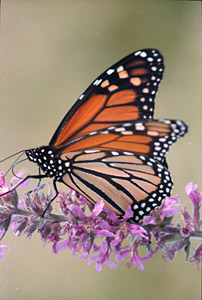 |
 |
| |

The naturalist Charles Darwin studied purple loosestrife extensively. The plant has three forms,
each with male and female flower parts of different sizes. These parts are arranged in ways that
prevent inbreeding as bees and other insects move among the flowers, transferring pollen.
| show TOC frame | Table of Contents | 
|
| Home / Contact | ||
Copyright © Anne A. Reid, 1999-2002. Photographs copyright © Garry K. Kessler, 1999-2002. | ||